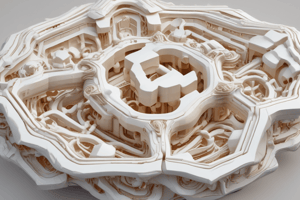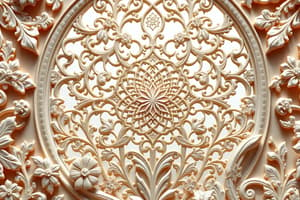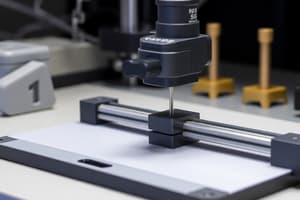Podcast
Questions and Answers
What is the primary purpose of converting a CAD model to STL format?
What is the primary purpose of converting a CAD model to STL format?
- To enhance the visual quality of the model
- To create a detailed engineering drawing
- To export as a 3D printing file
- To simplify the model's geometry for AM (correct)
The conversion to STL format is a manual process requiring significant user intervention.
The conversion to STL format is a manual process requiring significant user intervention.
False (B)
Name one application area of additive manufacturing that does not involve conventional CAD modeling.
Name one application area of additive manufacturing that does not involve conventional CAD modeling.
Medical modeling
The eight steps in the Additive Manufacturing process include conceptualization and CAD, conversion to STL, transfer and manipulation of STL file, _____, build, part removal and cleanup, post-processing of part, and application.
The eight steps in the Additive Manufacturing process include conceptualization and CAD, conversion to STL, transfer and manipulation of STL file, _____, build, part removal and cleanup, post-processing of part, and application.
Match the type of additive manufacturing system with its description:
Match the type of additive manufacturing system with its description:
What are common considerations in the design for additive manufacturing?
What are common considerations in the design for additive manufacturing?
Energy density is an important factor in metal additive manufacturing systems.
Energy density is an important factor in metal additive manufacturing systems.
What is one of the initial actions required prior to building a part?
What is one of the initial actions required prior to building a part?
What is the significance of part removal and cleanup in the additive manufacturing process?
What is the significance of part removal and cleanup in the additive manufacturing process?
All AM machines must run a variety of materials with numerous setup parameters.
All AM machines must run a variety of materials with numerous setup parameters.
What is the purpose of repositioning the part before building?
What is the purpose of repositioning the part before building?
Parts may require _____ or coating allowances.
Parts may require _____ or coating allowances.
Match the following actions with their related descriptions:
Match the following actions with their related descriptions:
During which phase does the process switch to computer-controlled building?
During which phase does the process switch to computer-controlled building?
All AM machines alert the user when the build is complete or when there is no source material remaining.
All AM machines alert the user when the build is complete or when there is no source material remaining.
What does significant manual finishing typically entail for parts produced by AM machines?
What does significant manual finishing typically entail for parts produced by AM machines?
What is the role of support structures in additive manufacturing?
What is the role of support structures in additive manufacturing?
Post-processing tasks always require the use of power tools.
Post-processing tasks always require the use of power tools.
What are some common post-processing techniques used in additive manufacturing?
What are some common post-processing techniques used in additive manufacturing?
AM materials often have small _____ trapped inside them, leading to potential failure under stress.
AM materials often have small _____ trapped inside them, leading to potential failure under stress.
What is a potential consequence of poor technique in support removal?
What is a potential consequence of poor technique in support removal?
Match the additive manufacturing issues with their descriptions:
Match the additive manufacturing issues with their descriptions:
Many applications using AM processes do not require high performance from their _____
Many applications using AM processes do not require high performance from their _____
Why may parts produced by additive manufacturing behave differently than those made by conventional methods?
Why may parts produced by additive manufacturing behave differently than those made by conventional methods?
What is the nominal layer thickness range for most SL technology machines?
What is the nominal layer thickness range for most SL technology machines?
Thicker layers in additive manufacturing (AM) lead to parts being built more precisely.
Thicker layers in additive manufacturing (AM) lead to parts being built more precisely.
What material property must be considered during post-processing that involves heat?
What material property must be considered during post-processing that involves heat?
In powder-based systems, there is no need to use _____
In powder-based systems, there is no need to use _____
Match the following AM technologies with their characteristics:
Match the following AM technologies with their characteristics:
What is an advantage of photopolymer-based systems?
What is an advantage of photopolymer-based systems?
Newer resins in photopolymer systems offer improved temperature resistance and strength.
Newer resins in photopolymer systems offer improved temperature resistance and strength.
What type of machine typically has a nominal layer thickness of 0.254 mm?
What type of machine typically has a nominal layer thickness of 0.254 mm?
What is a key requirement for molten material systems that melt and deposit materials in a molten state?
What is a key requirement for molten material systems that melt and deposit materials in a molten state?
Extrusion processes like FDM always generate supports automatically.
Extrusion processes like FDM always generate supports automatically.
What is one of the challenges faced when cleaning parts produced by lamination methods?
What is one of the challenges faced when cleaning parts produced by lamination methods?
Exposure to _____ and excessive light should be avoided in material handling.
Exposure to _____ and excessive light should be avoided in material handling.
Match the following application areas with their respective technology:
Match the following application areas with their respective technology:
Which of the following is NOT a factor to consider in metal systems?
Which of the following is NOT a factor to consider in metal systems?
List two design considerations for additive manufacturing.
List two design considerations for additive manufacturing.
Some machines in additive manufacturing must be kept away from _____ environments.
Some machines in additive manufacturing must be kept away from _____ environments.
Which of the following is a type of Vat Photopolymerization process?
Which of the following is a type of Vat Photopolymerization process?
Two-Photon Vat Photopolymerization offers only advantages and no drawbacks.
Two-Photon Vat Photopolymerization offers only advantages and no drawbacks.
What is one of the key components of photopolymer chemistry?
What is one of the key components of photopolymer chemistry?
The process that models irradiance and exposure in Vat Photopolymerization is known as _____
The process that models irradiance and exposure in Vat Photopolymerization is known as _____
Match the following scan patterns with their descriptions:
Match the following scan patterns with their descriptions:
Which of the following radiation types is primarily used to cure commercial photopolymers?
Which of the following radiation types is primarily used to cure commercial photopolymers?
Epoxy and vinylether are examples of free radical polymerization.
Epoxy and vinylether are examples of free radical polymerization.
What is the role of a photoinitiator in photopolymerization?
What is the role of a photoinitiator in photopolymerization?
Photopolymer resins must be cleaned, post-cured, and _____ after building.
Photopolymer resins must be cleaned, post-cured, and _____ after building.
Match the following photopolymerization processes with their respective characteristics:
Match the following photopolymerization processes with their respective characteristics:
What component of the laser scan VP machines is responsible for liquid resin application?
What component of the laser scan VP machines is responsible for liquid resin application?
Both di-functional and higher functionality monomers are commonly used in SL resins.
Both di-functional and higher functionality monomers are commonly used in SL resins.
Name two main subsystems of vector scan VP machines.
Name two main subsystems of vector scan VP machines.
Which approach in photopolymerization does not require recoating of the resin layer?
Which approach in photopolymerization does not require recoating of the resin layer?
In the microelectronic industry, visible light is predominantly used for photomask materials.
In the microelectronic industry, visible light is predominantly used for photomask materials.
What device is used to pattern the large radiation beam in the mask projection approach?
What device is used to pattern the large radiation beam in the mask projection approach?
In photopolymerization processes, the _____ scan approach is typical of commercial SL machines.
In photopolymerization processes, the _____ scan approach is typical of commercial SL machines.
Match the photopolymerization approaches with their descriptions:
Match the photopolymerization approaches with their descriptions:
What type of light is primarily used in photopolymerization processes?
What type of light is primarily used in photopolymerization processes?
Charles Hull discovered solid polymer patterns by exposing UV curable materials to a scanning laser.
Charles Hull discovered solid polymer patterns by exposing UV curable materials to a scanning laser.
What is one common application of photo-curable resins in dentistry?
What is one common application of photo-curable resins in dentistry?
The mid 1980s marked the beginning of SL technology due to Charles Hull's experiments with _____ curable materials.
The mid 1980s marked the beginning of SL technology due to Charles Hull's experiments with _____ curable materials.
Match the following radiation types with their uses in curing commercial photopolymers:
Match the following radiation types with their uses in curing commercial photopolymers:
What is a significant drawback of vat photopolymerization technology?
What is a significant drawback of vat photopolymerization technology?
The surface finish of SL parts can range from submicron to over 100 um Ra depending on the orientation of the surfaces.
The surface finish of SL parts can range from submicron to over 100 um Ra depending on the orientation of the surfaces.
What is the maximum size of fabrication structure achievable with the specified microsterolithography process?
What is the maximum size of fabrication structure achievable with the specified microsterolithography process?
The minimum size of a hardened polymer unit in the microsterolithography process is _____ in the x and y directions.
The minimum size of a hardened polymer unit in the microsterolithography process is _____ in the x and y directions.
Match the advantages of vat photopolymerization technology with their descriptions:
Match the advantages of vat photopolymerization technology with their descriptions:
Which of the following statements about mask projection VP technologies is true?
Which of the following statements about mask projection VP technologies is true?
Photopolymers used in additive manufacturing are known for their exceptional impact strength and durability.
Photopolymers used in additive manufacturing are known for their exceptional impact strength and durability.
What is the position accuracy achieved in the x-y directions during the microsterolithography process?
What is the position accuracy achieved in the x-y directions during the microsterolithography process?
When laser light is focused on a particular area for a long time, then that particular area alone will be heated.
When laser light is focused on a particular area for a long time, then that particular area alone will be heated.
Laser technology is well suited for integration into modern systems like CAD and CAM.
Laser technology is well suited for integration into modern systems like CAD and CAM.
Electromagnetic waves that are applied in Mobile Phones are called:
Electromagnetic waves that are applied in Mobile Phones are called:
Purposes of laser material processing is based on the interaction of lasers with solid materials.
Purposes of laser material processing is based on the interaction of lasers with solid materials.
The Relations between the wavelength λ and frequency is:
The Relations between the wavelength λ and frequency is:
All the radiation in the electromagnetic waves have the same wavelength.
All the radiation in the electromagnetic waves have the same wavelength.
What is the full form of LASER and the acronym stand for?
What is the full form of LASER and the acronym stand for?
The smallest particle (Quantum) in light is called _____
The smallest particle (Quantum) in light is called _____
Flashcards are hidden until you start studying
Study Notes
Additive Manufacturing (AM)
- Converting a CAD model to STL format simplifies the model's geometry for additive manufacturing (AM).
- The conversion process is manual and requires user intervention.
- AM has an application area in medical modeling that does not involve traditional CAD modeling.
- The eight steps of the AM process are: conceptualization and CAD, conversion to STL, transfer and manipulation of STL file, machine setup, build, part removal and cleanup, post-processing of part, and application.
- Key considerations in AM design include part orientation and removal of supports.
- Energy density is a critical factor in metal AM systems.
- Before building a part, use the visualization tool for verification.
- Part removal and cleanup ensure the final product is free from excess material and ready for use.
- All AM machines require specific setup parameters for different materials.
- Repositioning the part before building allows for precise placement within the machine.
- Parts may require shrinkage or coating allowances during production.
- The machine setup phase involves configuring operating parameters.
- Segmentation of STL files divides parts for easier handling.
- The manufacturing process switches to computer-controlled building during the layer-based manufacturing phase.
- AM machines alert the user when the build is complete or when there is no material remaining.
- Significant manual finishing for AM parts typically involves cleaning and preparing them for use.
- Support structures stabilize parts during the building process.
- Post-processing tasks may not always require power tools.
- Common post-processing techniques include abrasive finishing, polishing, sandpapering, and applying coatings.
- AM materials often contain trapped voids, which can lead to failure under stress.
- Poor support removal technique can result in low-quality output.
- Anisotropic properties in AM materials mean different properties in different directions.
- Material degradation in AM can result from improper bonding or crystallization.
- Support removal often requires manual skill to avoid damaging parts.
- Application specificity refers to the specific requirements of the final product.
- Many AM applications do not require high performance from components.
- Parts produced by AM can behave differently from conventionally made parts due to voids, anisotropic properties, or material degradation.
Stereolithography (SL)
- The nominal layer thickness range for most SL machines is 0.05 - 0.1 mm.
- Thicker layers in AM lead to less precise parts.
- Heat resistance or melting temperature of the material must be considered during post-processing involving heat.
- Powder-based systems do not require support structures.
- Photopolymer-based systems require support structures made from the same material as the part.
- Powder-based systems deposit a bed of powder layer-by-layer.
- Droplet deposition systems allow for modifying the support material during printing.
- Binder printing systems can color parts using colored binder material.
- Photopolymer-based systems offer good accuracy with thin layers.
- Newer resins in photopolymer systems provide improved temperature resistance and strength.
- FDM Dimension machines typically have a nominal layer thickness of 0.254 mm.
- Molten material systems require support structures because materials melt and are deposited in a molten state.
- Extrusion processes in FDM do not always generate supports automatically.
- Cleaning parts produced by lamination methods is a laborious process due to waste material removal.
- Material handling requires protection from moisture and excessive light.
Vat Photopolymerization (VP)
- Vat photopolymerization is a type of additive manufacturing process that uses light to solidify a liquid resin.
- It is used in applications like medical modeling.
- The most common radiation type for curing commercial photopolymers is UV light.
- Photopolymer resins require cleaning, post-curing, and finishing after building.
- Free radical polymerization is typically found in acrylate-based photopolymer resins.
- Epoxy and vinylether are used in cationic polymerization.
- Resin formulation involves the use of multifunctional monomers.
- Interpenetrating polymer networks are formed by acrylate and epoxides.
- The recoater system in VP machines applies liquid resin.
- Both di-functional and higher functionality monomers are commonly used in SL resins.
- Vector scan VP machines have subsystems for laser and optics, and control systems.
- The two-photon approach does not require recoating of the resin layer in VP.
- Visible light is not predominantly used for photomask materials in the microelectronic industry.
- A digital micromirror device is used to pattern the radiation beam in the mask projection approach.
- The vector scan approach is common in commercial SL machines.
- Layer-wise approach involves successive layer applications in photopolymerization.\
- The mask projection approach involves scanning laser beams across the resin bath.
- The two-photon approach provides high resolution point-by-point solidification.
- Charles Hull discovered solid polymer patterns by exposing UV-curable materials to a scanning laser.
- UV-curable materials were used in the early experiments of SL technology in the mid 1980s.
- Gamma rays are used for various curing applications, while X-rays are used in treating medical materials.
- A significant drawback of vat photopolymerization technology is the limited chemistries for photopolymers.
- The surface finish of SL parts can vary depending on the orientation of the surfaces.
- Microsterolithography can produce fabrication structures up to 10 mm x 10 mm x 10 mm in size.
- The minimum hardened polymer unit size in microsterolithography is 5 µm in both the x and y directions.
- Microsterolithography offers accuracy of 0.25 µm in the x-y directions.
Lasers
- Laser technology is well suited for integration into modern CAD and CAM systems.
- Focusing laser light on a particular area for an extended period will heat that specific area.
- Mobile phones utilize radio waves for communication.
- Laser material processing is driven by interactions between lasers and solid materials.
- The relationship between wavelength (λ) and frequency is inversely proportional.
- Different types of electromagnetic radiation have different wavelengths.
- LASER stands for Light Amplification by Stimulated Emission of Radiations.
- Photons are the smallest particles (quanta) in light.
Studying That Suits You
Use AI to generate personalized quizzes and flashcards to suit your learning preferences.




